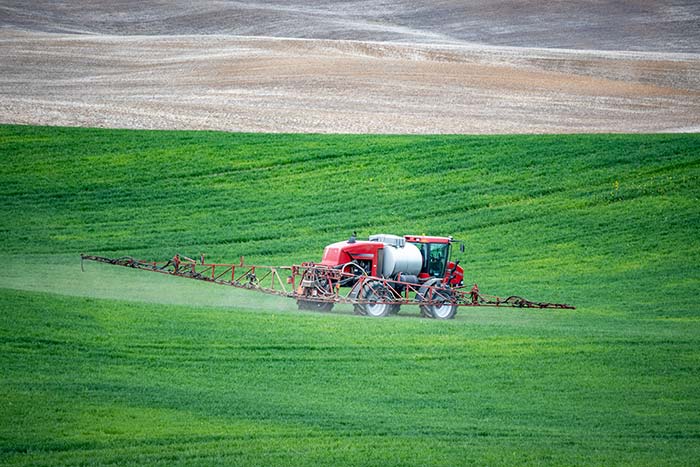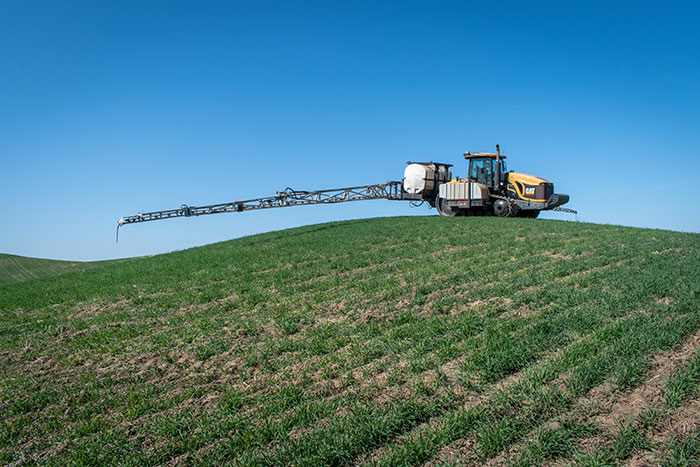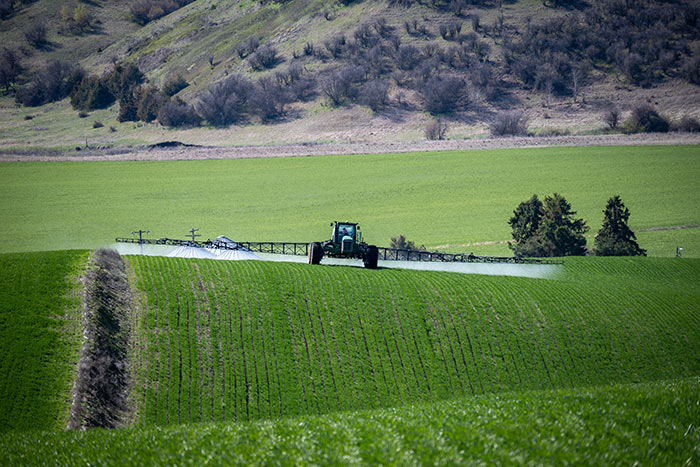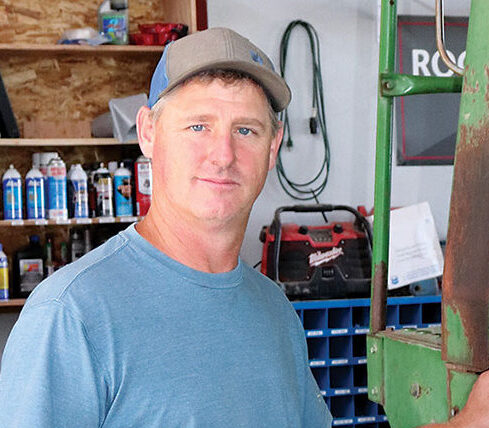The most expensive herbicide application is the one that doesn’t work. As we move through a season where commodity prices are very challenging, maximizing our investment in herbicides is critical. Achieving the best results from a herbicide application requires more than simply selecting a product and spraying it on a field. Many factors influence the effectiveness of herbicides, including application timing, environmental conditions, and proper use of equipment. Indeed, poorly executed applications can lead to increased costs, poor weed control, and the development of herbicide-resistant weed populations. To ensure the highest level of weed control while minimizing negative consequences, it is important to follow a few simple best management practices (BMPs) when applying herbicides.
One of the most fundamental aspects of herbicide application is understanding the difference between contact and systemic herbicides. Contact herbicides, as the name suggests, kill only the plant tissue they come into direct contact with. These products do not move within the plant, so complete and uniform coverage is essential for effective control. Common contact herbicides include paraquat and bromoxynil (Gramoxone and Buctril, respectively), which act quickly and are often used for burn-down applications before planting or as part of a weed control program targeting small, actively growing weeds. Other commonly used contact herbicides include the PROTOX inhibiting herbicides Sharpen (salfufenacil) and Reviton (tiafenacil). In contrast, systemic herbicides are absorbed by the plant and move through its vascular system, allowing them to control weeds more effectively, even if coverage is not perfect. Glyphosate and 2,4-D are examples of systemic herbicides that translocate within the plant to reach growing points and kill it from the inside out. The choice between contact and systemic herbicides depends on the target weed species, application timing, climate conditions at application, and overall weed management strategy.
Timing is one of the most important factors in herbicide application. Applying herbicides at the correct stage of weed growth significantly improves their effectiveness. It’s often difficult to get timing right in the Pacific Northwest (PNW) because of our climate conditions in the spring. Young, actively growing weeds are more susceptible to herbicides than mature weeds with well-established root systems. Early applications can prevent weeds from reaching reproductive stages, reducing the seed bank and minimizing future weed pressure. Preemergence herbicides, which are applied before weed seedlings emerge, can provide residual control that suppresses weeds for an extended period and provide expanded windows for timing postemergence herbicide applications. Postemergence herbicides, on the other hand, are applied after weeds have emerged and require proper timing to maximize control. Delayed applications may result in reduced effectiveness, requiring higher herbicide rates or additional applications, increasing costs and the risk of herbicide resistance. We encourage farmers to cultivate a mindset around ensuring every weed exposed to an herbicide dies before setting seed.
Environmental conditions play a major role in determining how well an herbicide performs. Temperature, humidity, and soil moisture all affect herbicide absorption and activity. Warm temperatures generally enhance herbicide uptake, but extreme heat can cause rapid droplet evaporation, reducing the amount of herbicide reaching the target weeds. Wind speed and direction should also be considered to minimize spray drift, which can lead to off-target damage to sensitive crops, nontarget plants, and even water sources. High humidity can improve herbicide effectiveness by reducing evaporation, while drought-stressed weeds may be less responsive due to slowed metabolism, reduced translocation of systemic herbicides, or increased wax layers on leaf surfaces that reduce herbicide uptake. As we all know, the change from high humidity to heat and drought can occur in the same day in the PNW. For soil-applied herbicides, rainfall is essential to activate the chemical and move it into the root zone, where it can effectively prevent weed emergence. We are actively exploring how to shift application timings to better address weed emergence and early growth periods.
 Proper application techniques ensure that herbicides reach the intended target in the correct amounts. Using the right spray nozzles, pressure settings, and carrier volumes are critical for achieving uniform coverage. Contact herbicides require fine droplets and high spray volumes to ensure complete leaf coverage, whereas medium to course droplets, which are less likely to drift off target than fine droplets, work well for systemic herbicides due to their ability to move within the plant. State regulations influence our ability to spray when fine droplets are generated. Additionally, using the right surfactants and adjuvants can enhance herbicide uptake and spread, especially on plants with waxy or hairy leaf surfaces that can repel water-based sprays. Always follow herbicide label recommendations for application rates and tankmix instructions to avoid compatibility issues that could reduce efficacy or cause crop injury and use a high-quality surfactant.
Proper application techniques ensure that herbicides reach the intended target in the correct amounts. Using the right spray nozzles, pressure settings, and carrier volumes are critical for achieving uniform coverage. Contact herbicides require fine droplets and high spray volumes to ensure complete leaf coverage, whereas medium to course droplets, which are less likely to drift off target than fine droplets, work well for systemic herbicides due to their ability to move within the plant. State regulations influence our ability to spray when fine droplets are generated. Additionally, using the right surfactants and adjuvants can enhance herbicide uptake and spread, especially on plants with waxy or hairy leaf surfaces that can repel water-based sprays. Always follow herbicide label recommendations for application rates and tankmix instructions to avoid compatibility issues that could reduce efficacy or cause crop injury and use a high-quality surfactant.
Tank mixing herbicides with different modes of action is an effective strategy for managing herbicide resistance and broadening weed control. However, it is important to ensure that tank-mixed products are compatible and do not negatively interact with or antagonize each other. Some herbicides require specific order-of-mixing protocols to prevent issues such as poor solubility or reduced effectiveness. Additionally, rotating herbicide modes of action from season to season can help delay the development of resistant weed populations.
Over-reliance on a single herbicide or repeated use of the same mode of action can lead to the selection of herbicide-resistant weeds, making future control more difficult and expensive. As mentioned previously, it’s important that all the weeds that are treated with an herbicide die before setting seed.
 Proper record-keeping is an often overlooked but essential component of effective herbicide application. Keeping detailed records of herbicide use, including product names, application rates, weed species targeted, environmental conditions, and application timing, helps farmers and applicators track the success of their weed management programs. These records can also provide insights for making adjustments in future applications and can be useful in cases where herbicide performance issues arise. Additionally, documentation of herbicide applications is required for compliance with pesticide regulations and environmental stewardship programs.
Proper record-keeping is an often overlooked but essential component of effective herbicide application. Keeping detailed records of herbicide use, including product names, application rates, weed species targeted, environmental conditions, and application timing, helps farmers and applicators track the success of their weed management programs. These records can also provide insights for making adjustments in future applications and can be useful in cases where herbicide performance issues arise. Additionally, documentation of herbicide applications is required for compliance with pesticide regulations and environmental stewardship programs.
Integrated weed management (IWM) is a holistic approach that combines herbicide applications with nonchemical control methods to reduce reliance on herbicides and slow the spread of resistant weeds. The PNW Extension publication 754, Best Management Practices for Managing Herbicide Resistance, is a good source of additional information on this topic. Crop rotation, cover cropping, mechanical cultivation, cleaning equipment before moving to new fields, buying clean seed, and altering planting dates are all practices that can complement chemical weed control. By incorporating multiple weed management strategies, farmers can create a more resilient and sustainable approach to weed control that reduces herbicide use while maintaining high levels of productivity.
Overall, achieving the best results from herbicide applications requires careful planning, attention to detail, and adherence to best management practices. Understanding the differences between contact and systemic herbicides, applying herbicides at the optimal time, considering environmental conditions, using proper equipment and techniques, and implementing integrated weed management strategies are all essential components of an effective weed control program. By following these principles, farmers can maximize the effectiveness of herbicides, reduce costs, and ensure long-term sustainability in weed management.
This article originally appeared in the March 2025 issue of Wheat Life Magazine.



